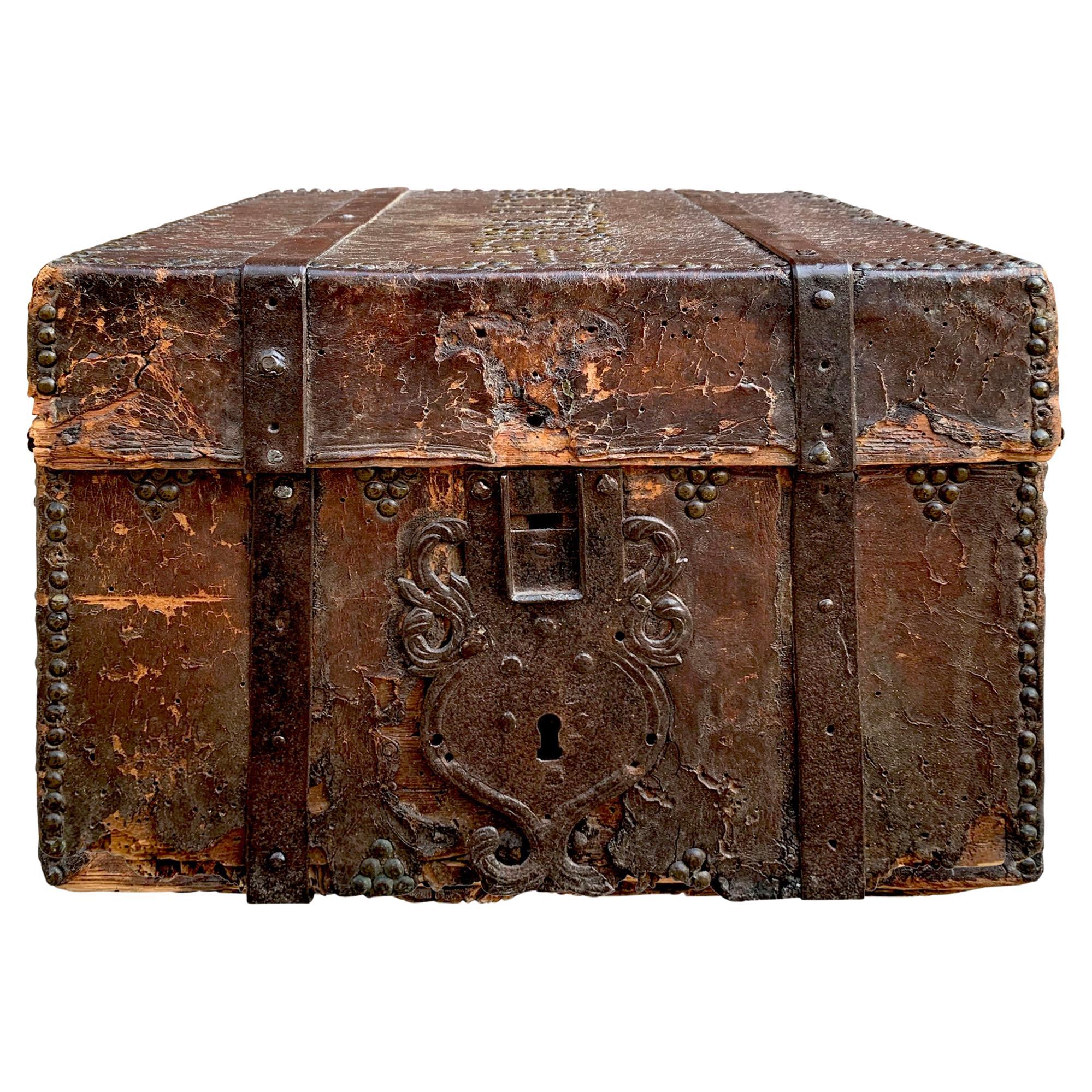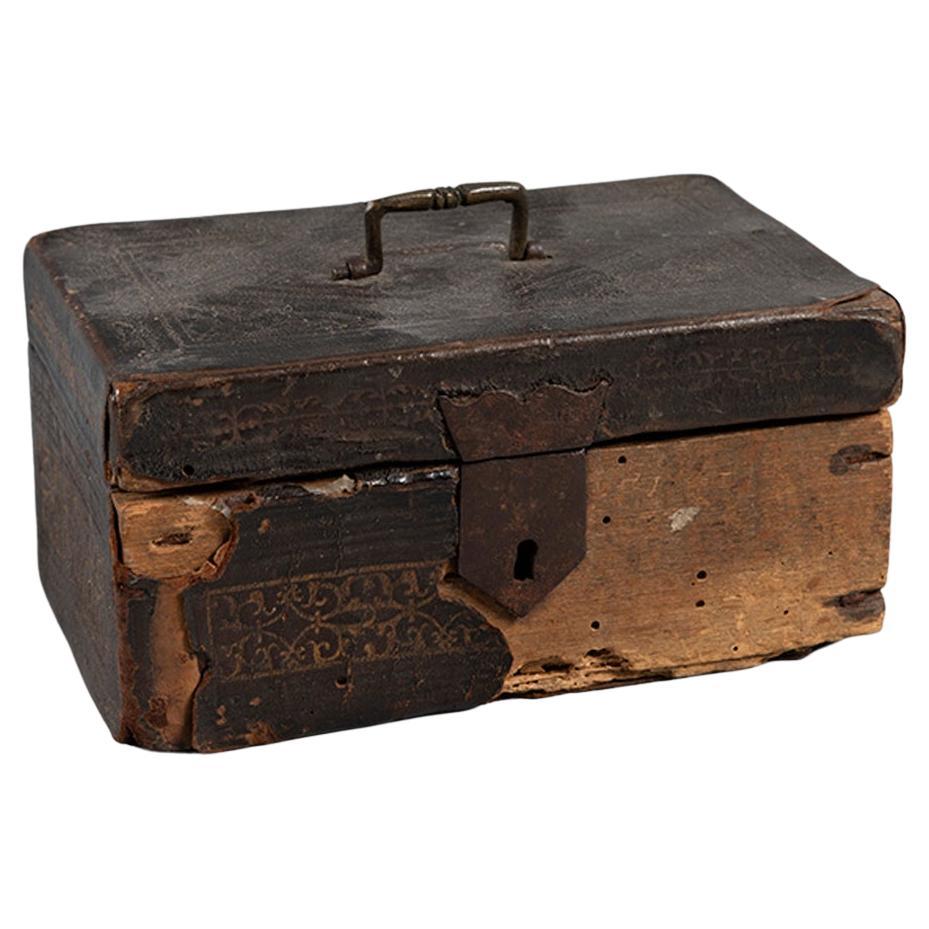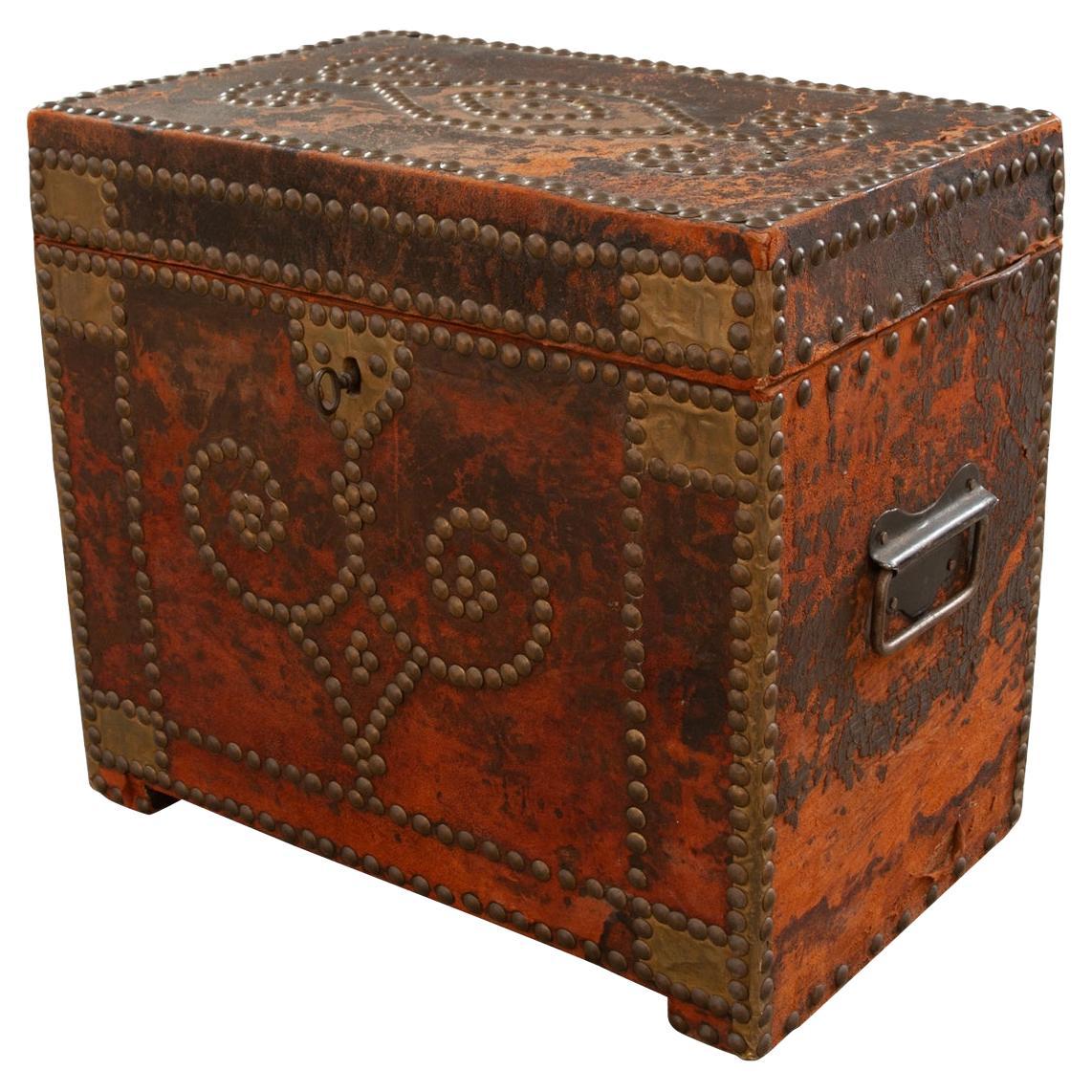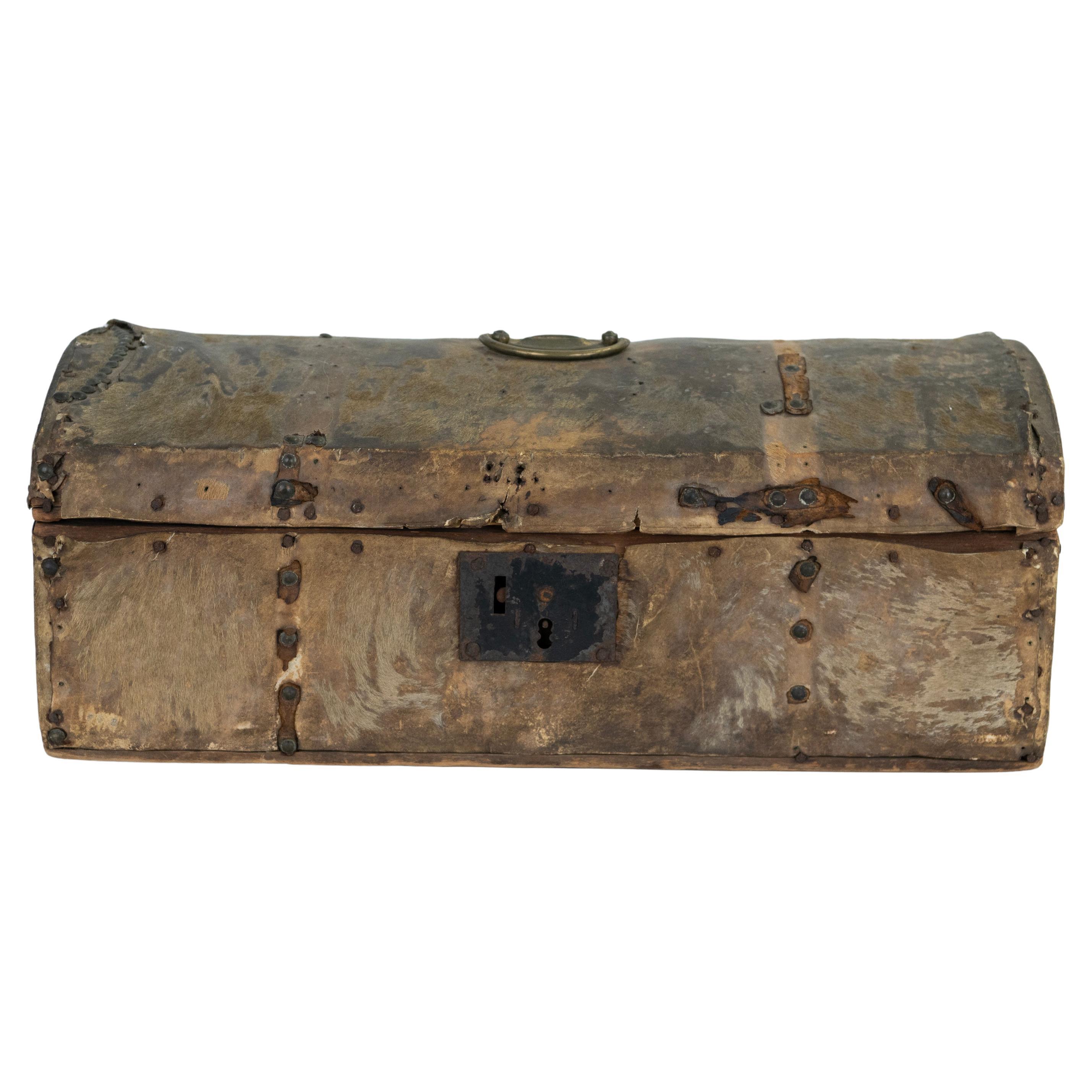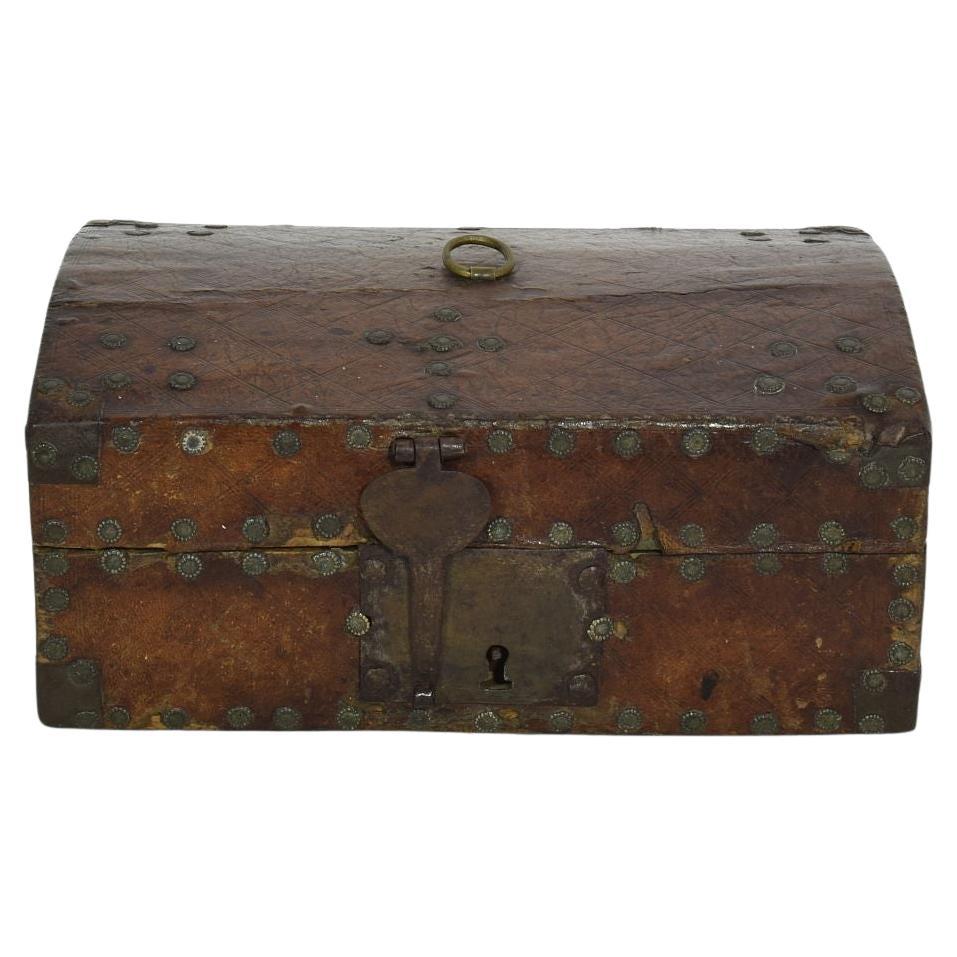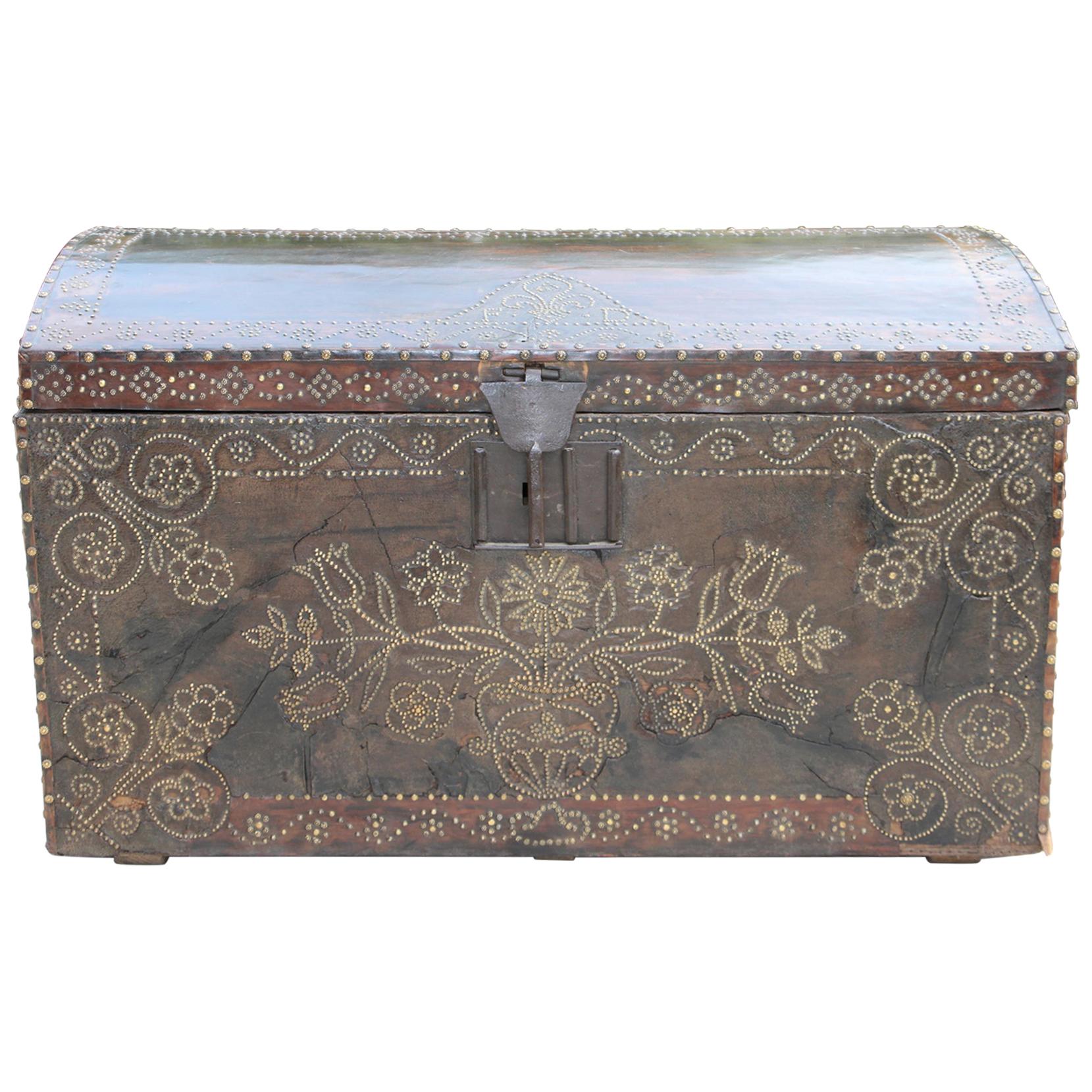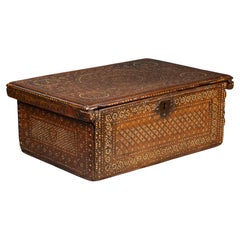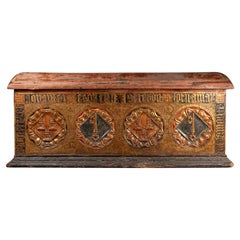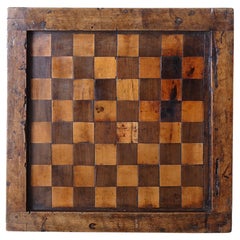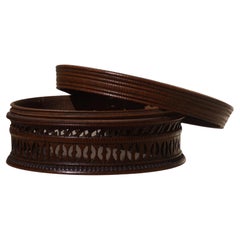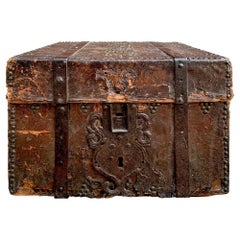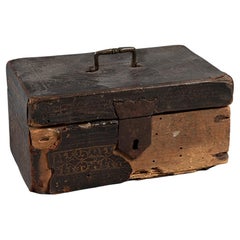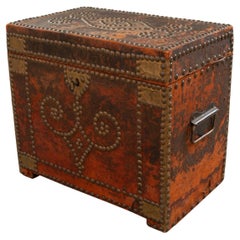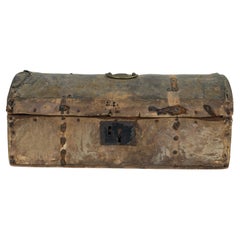Items Similar to Boiled Leather Trunk, Spanish, 17th Century
Want more images or videos?
Request additional images or videos from the seller
1 of 5
Boiled Leather Trunk, Spanish, 17th Century
$12,902.49
$21,504.1440% Off
£9,642.67
£16,071.1240% Off
€10,800
€18,00040% Off
CA$17,799.62
CA$29,666.0440% Off
A$19,496.11
A$32,493.5140% Off
CHF 10,264.70
CHF 17,107.8440% Off
MX$232,679.55
MX$387,799.2540% Off
NOK 130,814.43
NOK 218,024.0540% Off
SEK 119,584.10
SEK 199,306.8440% Off
DKK 82,319.15
DKK 137,198.5840% Off
About the Item
Leather trunk
Spanish, 17th century
Boiled Leather, wood and iron
Measures: 22 x 53 x 32 cm.
Provenance :
- collection Metz-Noblat, Château de Clevant, France
Rectangular trunk of the form and size of a small suitcase with wrought iron hinges and lock-plate.
Wood, covered with leather, cut and embossed with every surface of the thick cow hide covered in interlace, zoomorphic features.
The construction method is boiled leather, often referred to by its French translation cuir-bouilli: a process used to change flexible, vegetable-tanned leather into rigid, moulded objects. For shaping of the vegetable-tanned leather, heat and moisture were used, as indicated by the term boiled leather. No written medieval sources describing the production of decorated cuir bouilli objects survive, so knowledge of the process relies on the important studies of the Scottish leather historian John William Waterer. A large range of methods, materials and techniques could be used in various combinations. The vegetable-tanned leather, made supple with moisture and heat, was stuffed, shaped and nailed to the rigid wooden coffer support. The stuffing material was probably modeled beeswax or stearin wax. To shape the leather, to create its topography, « Cushions » were made by lacing a thread through an awl hole and attaching the flexible leather and stuffing to the rigid wooden support on the bottom. Then the decoration was done: lines were incised through the upper layer of the leather (epidermis) with different thicknesses of knives or needles. Contours were created with deep v-shaped cuts, decoration with thin incision and final details with a needle point. For the incision and pouncing stage, the leather was probably kept heated and moistened for suppleness.
Once dry, the leather would be hard and rigid.
the saturated leather is worked over a form, possibly even damp sand, with the pattern shaped using bone or wooden tools. Compare to metal, leather was lighter and it offered protection from cuts and punctures. Cuir bouilli objects were produced by specialist leather workers and needed skillful craftsmanship.
The surface is filled with roundels shaped foliages enclosing animals, lions and peacocks. The foliate arabesques creating a vegetal connection tweet the animals create the impression of a lush verdant space . The vegetal pattern here employed in combination with geometrical pattern came from the pre-islamic artistic traditions of the Byzantine and Sasanian empires. An aspect of Islamic geometry Is the basic symmetrical repetition and mirroring of the shapes that create a sense of harmony.
The decoration of this truck is inspired by the islamic « arabesque » a form of vegetal ornament composed of spirals, intertwining plants and abstract curvilinear motifs. An arabesque character is given to the birds of the decorations through extreme stylisation. This arabesque maintained the classical tradition of median symmetry, freedom in Detail and heterogeneity of ornament.
The presence of the peacocks is a paradisiacal allusion: in popular Islamic literature they were among the original inhabitants of the garden of Paradise expelled with Adam and Eve. Peacock as a decorative motif may have originated in the West, despite their eastern provenance. There was an ancient belief that the flesh and feathers of peacock do not decay. This led to the peacock becoming a christian symbol for Christ’s resurrection.
Renowned for their decorative wall hangings, seventeenth-century Spanish leatherworkers also produced utilitarian objects, such as this trunk. A similar trunk is on display at the Metropolitan museum of art ( 09.158.1).
Related literature :
Davies L. 2006. Cuir bouilli. Conservation of leather and related materials, 94-102, Oxford: elsevier Butterworth-Heinemann
Grabar, Oleg. The Mediation of Ornament. Princeton: Princeton University Press, 1992
Gabriela Germana Roquez, "El mueble en el Peru en el siglo XVIII: estillos, gustos y costumbres de la elite colonial", in Anales del Museo de America 16 (2008), pp. 189-206
Department of Islamic Art. “Vegetal Patterns in Islamic Art.” In Heilbrunn Timeline of Art History. New York: The Metropolitan Museum of Art, 2000.
- Dimensions:Height: 8.67 in (22 cm)Width: 20.87 in (53 cm)Depth: 12.6 in (32 cm)
- Materials and Techniques:
- Period:
- Date of Manufacture:17th Century
- Condition:Wear consistent with age and use.
- Seller Location:Bruxelles, BE
- Reference Number:1stDibs: LU6666233656952
About the Seller
5.0
Vetted Professional Seller
Every seller passes strict standards for authenticity and reliability
1stDibs seller since 2022
15 sales on 1stDibs
Typical response time: 1 hour
- ShippingRetrieving quote...Shipping from: Bruxelles, Belgium
- Return Policy
More From This Seller
View AllHispano-Moresque Mudéjar Bone-Inlaid Walnut Chest
- Spain, 16th century
Located in Bruxelles, BE
Hispano-Moresque Mudéjar Bone-Inlaid Walnut Chest
Spain, 16th–17th century
Walnut, bone inlay, iron fittings
44.5 × 30.5 × 18 cm
This rectangular walnut chest, richly ornamented ...
Category
Antique 16th Century Spanish Renaissance Decorative Boxes
Materials
Bone, Walnut
Rare pastiglia marriage chest - North of Italy, First half of 15th century
Located in Bruxelles, BE
Rare pastiglia marriage chest
North of Italy, Liguria or Piemonte
First half of 15th century
wood, gesso, partly gilded, form molded and painted
67 x 156 x 63 cm
Provenance :
Pri...
Category
Antique 15th Century and Earlier Italian Renaissance Blanket Chests
Materials
Gesso, Wood
Wood and leather game box - Italy, 19th century
Located in Bruxelles, BE
Wood and leather game box for chess, Nine men’s morris and Backgammon
Italy, 19th century
33 x 33,3 x 11,2 cm
Nine men’s morris also known as mill game (merelles, from the Latin wor...
Category
Antique 19th Century Italian Arts and Crafts Games
Materials
Leather, Wood
Turned, Engraved Openwork Box, Florence, 17th Century
Located in Bruxelles, BE
Turned, engraved and openwork box
Fruit wood
Florence, 17th century
Measures: Diameter 11cm
Height 4.4cm.
Category
Antique 17th Century Italian Renaissance Decorative Boxes
Materials
Wood
$764 Sale Price
20% Off
Dutch Tobacco Jar - 19th century
Located in Bruxelles, BE
Dutch Tobacco Jar
Netherlands, 19th century
23 x 15 cm
Georgian Dutch Tobacco Jar. Made from different woods, this ring turned Jars show a very nice patina.
Category
Antique 19th Century Dutch Georgian Snuff Boxes and Tobacco Boxes
Materials
Fruitwood
$691 Sale Price
35% Off
Grand Tour Cinerarium - 18th century
Located in Bruxelles, BE
18th century Grand Tour Cinerarium
Limestone, inlaid with Roman marble fragments and fresco's
Annotation of finding spot indistinctively written on the fragments ("forum trajan","for...
Category
Antique 18th Century Italian Grand Tour Urns
Materials
Limestone, Marble
You May Also Like
17th Century Italian Leather Box
Located in Chicago, IL
A stunning 17th century Italian leather covered wood trunk covered in brass nail heads, some spelling out a word on top, and with iron strap hinges a...
Category
Antique 17th Century Italian Baroque Decorative Boxes
Materials
Leather, Wood
Spanish Mudejar-Style Wooden and Leather-Covered Chest, circa 1500
Located in Marbella, ES
Mudejar-style chest. Spain, circa 1500.
Wood and leather.
A chest with a wooden core and leather lining. The leather has been embossed with stylised vegetal motifs on both sides, i...
Category
Antique 16th Century Spanish Decorative Boxes
Materials
Leather, Wood
English 19th Century Leather Trunk
Located in Baton Rouge, LA
We absolutely love this decorative trunk from England, wrapped in perfectly patinated Cordovan red leather adorned with brass studs in swirling patterns inspired by India. The lock is in working condition and includes one key. A pair of simple handles on each side make it easy to carry even when filled. The interior is lined with a (faded) red fabric that is fixed with leather cording to support the lid. Both decorative and functional, this unique petite trunk...
Category
Antique 19th Century English Anglo-Indian Decorative Boxes
Materials
Metal, Brass
19th Century Leather Hide Trunk/Box found in the Frontier of Argentina
Located in Wainscott, NY
An evocative 19th-century Argentine travel chest, constructed with a wood carcass tightly wrapped in natural cowhide and reinforced with hand- forged iron strapping. The domed lid-de...
Category
Antique 19th Century Argentine Decorative Boxes
Materials
Hide
Small 17th Century, French Coffer or Box in Leather
Located in Buisson, FR
Extremely old box that is covered with leather and metal decorations.
Rare find.
France, circa 1600-1700
Weathered and some losses.
Category
Antique 17th Century French Decorative Boxes
Materials
Leather, Wood
$950 Sale Price
49% Off
17th Century Leather Trunk, 17th Century Chest
Located in Saint-Ouen, FR
Very unique piece,this 17th century trunk features brown leather and a wonderful job of flowers drawing made with little brass studs.
It has got 2 iron side handles and an iron lock...
Category
Antique 17th Century French Commodes and Chests of Drawers
Materials
Leather, Wood
More Ways To Browse
Spanish Leather
17th Century Spanish Furniture
Antique Iron Plate
Needle Point
Garden Of Paradise
Antique Trucks
Antique Spanish Box
17th Century Wood Box
Spanish Leather Trunk
Spanish Leather Box
Adam Eve Wall Decorative Plates
Vintage Candy Box
Antique Campaign Box
Antique Collectors Box
Blue And White Porcelain Chinese Box
Chinese Red Box
Glass Trinket Box
Horse Box
